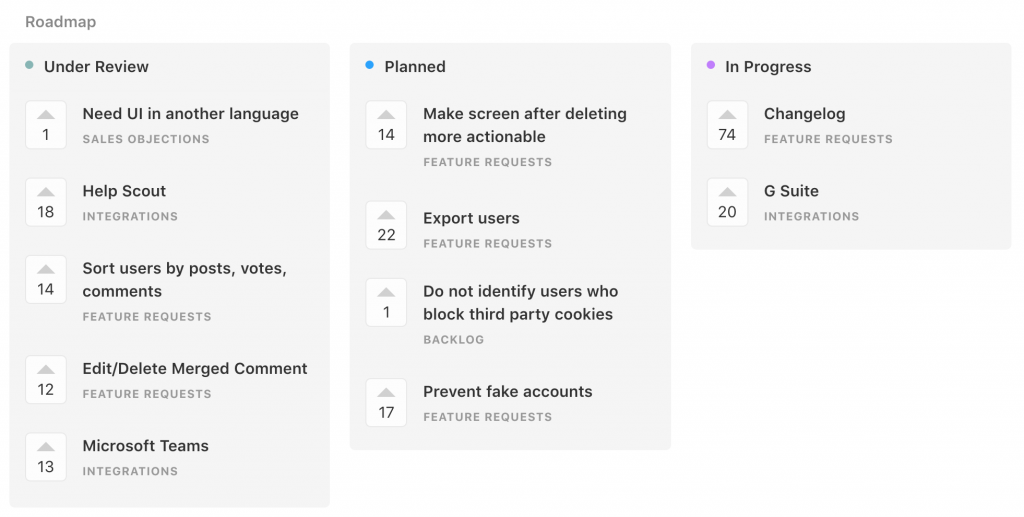In many companies, internal product roadmaps are for stakeholders, developers, and team leaders. More often than not, the rest of the company has little to no contact with it.
Roadmaps, when done well and kept updated, serve as the single source of truth for where the product is going. However, they’re often not discussed as widely as they should be.

Product roadmaps have benefits way beyond keeping development work organized. Getting to these benefits requires pulling product roadmaps out of their narrow context.
How internal transparency can benefit other teams
The smaller your team is, the easier it is to sync with each other. For example, we currently have 5 people at Canny. Everyone knows what’s going on with our product at any given time, because our “meetings” are all “company wide”.
The more your team grows, the harder it is to keep everyone aware of what’s going on. Edmund Lau describes it well in his article about communication being the first casualty of team growth:
…
Sharing information may no longer mean just giving someone else a quick heads up during a break; it might actually require a formally scheduled meeting with a large group of people.”
Every department or team in your company is there to work on and improve the same thing—your product or service.
- Marketing is there to sell it and communicate value
- Support is there to help people adapt to it and work on retention
- HR is there to hire more talented people to work on it
- etc.
If everyone is working for the same thing—the product—and the product roadmap is the single source of truth for it…
…then it doesn’t make sense to have non-product teams be left out of the loop, does it?
By not encouraging your teams to work together, you’re creating the great divide.

The image above describes the “great divide” between product and success teams. However, this divide tends to spread to other teams, too.
So, what are the benefits of various teams within your company having access to the roadmap?
Marketing and sales:
- Can sculpt their messaging and campaigns based on what’s coming
- Can prepare launches and announcements ahead of time
Customer support:
- Can let (potential) users know about estimates and plans when they ask
- Don’t have to constantly wait for replies from the product team
Customer success:
- Can plan communication for new features ahead of time
- Can make sure that changes in the product are represented in onboarding flows and other help documentation
HR:
- Knows what’s up and coming in the roadmap and can communicate that to candidates
- Knows what’s going on in the workflow so they can understand current employees better
However, the main value of opening up the product roadmap to everyone is less wasted time. Since everyone is working for the same goal, they need constant information about what’s going on.
If the roadmap is reserved for the product team, other departments have to go to them to find out what’s coming and when. Asking around and waiting for information is one of the biggest time wasters in team communication.

Having a public internal roadmap means that everyone has access to the plans. This reduces time spent on asking questions, and increases time for meaningful work.
How a public internal roadmap can help the company
Transparency is a good start—everyone can see the roadmap and inform themselves.
To really make the most out of this transparency, you also have to make sure everyone has input into it. Why is that important?
Everyone in your company has different insights and they vary a lot based on their specific job. The modern startup organization has a lot of moving parts.

- Marketing people have insights into how the target group is changing
- Support people have insights into what the customers are saying and what they need/want
- HR people have insights into how potential employees see the company
- …etc.
This gives product teams several new and different POVs that they might have not even thought of.
It’s a simple diversity principle. The more eyes you have on the roadmap, the more it will be optimized based on different information.
Your product will be much more resilient to changes outside of the product team scope.
It also helps everyone in the team feel involved. Remember—everyone is working for the same thing. Feeling like their opinion and knowledge matters when it comes to product is an awesome motivator.
Making access and input happen
Now you know the benefits of having the roadmap accessible and open for everyone. It’s time to make it happen.
The first thing to do is have a discussion with your product team. There’s a chance they won’t take it well.
Product people can often feel like the roadmap is their “baby”, and “outsiders” are just going to break it. This is almost always an unreasonable fear, but that doesn’t make it any less real.

Make sure everyone has the chance to express any concerns.
Assure them that the goal of this isn’t to make everyone else in the company equally responsible for the product. It’s to reveal aspects they might find interesting and useful when planning.
They’re still in charge of the product. But, everyone else will feel better, and spend less time on hounding the product team. It’s a win/win situation.
Hopefully, everyone will be on board.
Then, you can start working on accessibility for the rest of the team.
- Make sure that everyone in the team has physical access to your roadmap, whether it’s in Trello, Canny, or somewhere else
- Then, let everyone know that they have access
When talking about why this is a good thing, address both:
- the information aspect (this is the single source of truth for what’s coming up with the product)
- the productivity aspect (teams don’t have to constantly guess or wait for replies from product team)
Making people give input is even harder. Letting people know they have access to the roadmap isn’t enough. This is an unusual permission for many non-product people.
They people can be scared to express their opinion, because they can feel like it’s not “relevant” or “accurate”. If you don’t specifically invite and encourage them to give feedback, they’ll look, but not touch.
Emphasize that their insight isn’t there to guide the product roadmap. That sounds very intimidating. It’s to inform it with their experience and knowledge.
Their role in the company can help the whole team succeed.

In the beginning, it might be easier to have meetings or calls around this. You can go over how the roadmap works and what kind of feedback the product team would like.
Having everyone in the same “room” talking about it will hopefully ease any tension. Real time discussions also allow for any questions anyone might have.
From there, you can set up other ways of having a discussion about product.
Toptal has an interesting article about the structured Technology Product Canvas, which is a great start for aligning teams.
Whether you choose that, meetings, or a Slack channel, make sure there’s an easy place for communication.
Diversity is the key to product strength
Product roadmaps tend to be the single source of truth for the future of the product.
However, in many companies, it is locked away from non-product teams. This siloes departments, makes people feel left out, and causes giant productivity blocks.
Releasing your product team’s “baby” to the rest of the company can be scary. However, if you manage to encourage people from other areas to speak up and give feedback, it’ll pay off.
If you make your product roadmap public for the whole company, it can help other teams with coordinating their work. They can also provide invaluable feedback and context to the product team that they might not even thought of.
Is your product roadmap accessible to everyone in the company? If not, why?







